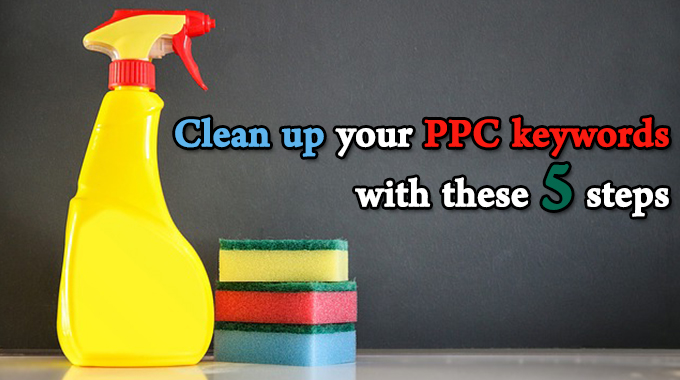Clean up your PPC keywords with these 5 steps

The Latest on Mobile Marketing: Marin’s Benchmark Report
Get the report today.
As spring rapidly approaches, there’s no better way to kick off the season than by performing a thorough PPC spring cleaning. By going back to your accounts, searching terms and lists, and sorting out everything unnecessary that has accumulated over the past few months (or even longer), you’ll be refreshed and prepared to face the new season head-on. Ultimately, if you want to succeed in promoting and growing your business, occasionally cleaning up target keywords in your PPC campaigns is a must.
Of course, there are plenty of other elements of your campaign you can clean up (ads, ad extensions, geo-targeting), so your PPC keywords are only the beginning. As you start the process, consider the following items.
1. Clean up Your Account Structure
Start cleaning up your account structure by examining your ad groups and campaigns. Analyze their performances and pause any that are under-performing or not bringing in value. This step will probably be your most arduous task, especially if you manage one or more large accounts.
Then, move on to restructuring your account and tightening your groups. (Groups of 10-15 keywords are optimal.) Organize your keyword groups into themes and keep them targeted, taking care to ensure each ad group has relevant and similarly themed keywords so that the ad shown matches the keywords used in a search. Users are less likely to convert if there’s a discrepancy between your ads and what they’re searching for. Additionally,consider placing your best and top-performing keywords into a group of their own, creating targeted copy for each of them.
2. Clean up Your Keyword Lists
To guarantee your PPC efforts are running smoothly, look at the different types of keywords and keyword lists you’ve created. Begin by removing keywords that are obsolete or just don’t perform well. Then, remove those that have received low impressions over time or no impressions at all, since these keywords have an impact on the overall Quality Score (QS) of the ad group and campaign in the long run. Try cleaning up inactive keywords that have no traffic or few impressions every 60 days. (You can reduce or extend the timeframe based on your personal judgment.)
Once you’ve eliminated unnecessary keywords, begin testing new keywords using competitor research. When you identify new keywords, develop them into new ad groups to target. New keywords are constantly emerging, so be on the lookout for popular keywords that aren’t already present in your account and add them.
While you’re at it, also make sure to revisit long-tail positive keywords and identify those that have a track record of converting. By adding these keywords, you’ll improve both your conversions and cost-per-acquisition (CPA). When implementing popular and long-tail search terms in your ads and landing pages, consider what terms people use when searching for their topics of interest; you’ll often find some real gems you might have overlooked.
Finally, when bidding, start by bidding highest for exact matches, followed by phrase and broad match types. That way you’ll be paying more for the most relevant searches.
3. Clean up Your Seasonal Keywords
Cleaning up your seasonal keywords is especially critical for B2C accounts, but it should also be done in a B2B environment. When cleaning up keywords—especially if you rely on seasonal ones—make sure you’ve paused any that aren’t applicable to the current season. (For example, by March your Christmas sale keywords should’ve been paused long ago.)
Furthermore, as you’re pausing irrelevant keywords (such as “winter coats”), rethink your budget allocation and redirect resources toward currently trending keywords (like “spring dresses”).
4. Clean up Your Negative Keywords
To clean up your negative keywords, perform an in-depth search term analysis in 14-, 30-, 60-, and 90-day windows to determine the keywords you need to target. Once you’ve nailed down the keywords that attract visits from people who aren’t in your target audience, negative match these not only at the ad group level, but also at the campaign and account levels.
In other words, by negative matching them, you’re effectively controlling who will see your ads—and making sure you aren’t paying for clicks from people who won’t convert.
You can also create a negative keyword list and add those keywords to all your campaigns, ensuring that when you create a new campaign, you won’t be leaving off any negative keywords. Managing your negative keywords is important because it allows you to make the most of your resources by reducing the costs on keywords that aren’t performing well. By tailoring your negative keywords, you’ll increase the visibility of your ads to people who are more likely to be interested in them.
5. Clean up Duplicate and Low QS Keywords
Duplicate keywords are a burden on your budget. Apart from having a negative impact on your Quality Score, they can cannibalize your budget if left unattended. This occurs when similar words end up in the same auctions, causing you to compete against yourself, along with driving up your cost-per-clicks (CPCs). Thus, as you perform your PPC spring cleanup, check for duplicate keywords and remove any you find.
In certain cases, it’s ok to duplicate keywords, especially if:
- You service different geo-locations
- You service different match types
- You service different networks (search versus display)
- Duplicates belong to different match types
Before you remove any inactive keywords, take the time to check why they’re inactive. Keyword hoarding (accumulating excessive amounts of keywords, many of which accrue little-to-no impressions) is certainly not desirable, yet optimizing your keywords is not entirely unrealistic either. Consider the following questions as you sift through your low QS:
- Is your landing page relevant and optimized for the specific keywords?
- Are your ads relevant? Are you using low QS keywords in your ad text?
- Are you using the right match type? Does phrase match give you a better QS than broad match?
- Are these keywords performing? If they are your top converting terms, contain high click-through-rate (CTR), and reasonable CPA, keep them.
These questions should be in the back of your mind as you clean out your keywords, groups, and lists. Based on your responses and conclusions, you may find that some of your inactive keywords are still usable.
___
by Alexander Kesler

